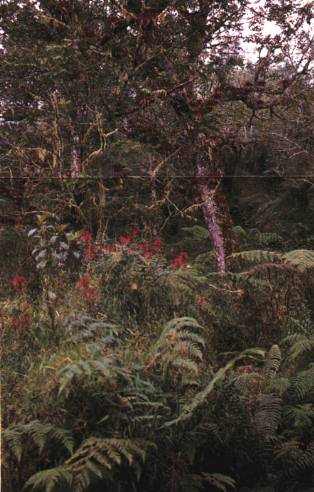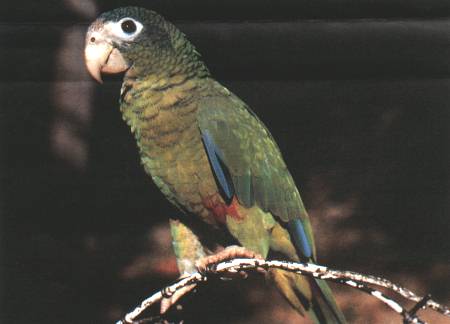 |
 |
|
|
|
Can Haiti dream of ecotourism ?
|
Despite centuries of degradation, Haiti still possesses abundant environmental attractions - but careful management is needed for ecotourism to really benefit the country.Article first published in ECODECISION / Spring 1996
© Paryski 1996 -Email: pparyski@aol.comversion francaise / Kiskeya Alternativa Haiti page
Haiti today is one of the poorest and most environmentally degraded countries in the world, but it was not always an environmental disaster area. In 1492, Columbus described the country as a paradise on earth. Three centuries later, a Polish officer named Lieutenant Wygeil, serving in the French expeditionary force sent to crush the Haitian Revolution, wrote: "If the country were at peace, it would surpass nearly all Europe in the beauty of its women, its crops and forests... [The officers] could not contain their admiration at the sight of diverse and innumerable plants so different from those of Europe."Unfortunately, there has been little peace in Haiti since 1803, when Wygeil made his observations. Political instability, demographic pressure, poverty and environmental degradation have ravaged this small Caribbean nation.
 |
 |
|
|
|
In 1985, shortly before the fall of Jean-Claude Duvalier, a USAID team of environmental experts concluded: "Few countries in the world lace a more serious threat to their own survival from environmental catastrophe than Haiti. Overpopulated, its resources overexploited and with trends towards further environmental deterioration everywhere, the country should brace itself for widespread famine, social upheaval and the potential breakdown of its socioeconomic and political structures."The years since the departure of the Duvalier regime have been exceptionally unstable, with coup d'états, shocking violence and economic decline. The remaining Duvalierists and the army have fought for control of the country's shrinking resources and riches, further oppressing the poor. The effect on the environment has been¡ devastating. Poor Haitian peasant have struggled to survive by deforesting and planting every available piece of land - often on slopes so steep that they must use ropes to work the fields; they also produced more charcoal to meet the increased demand resulting from the U.S. trade embargo. Without clear title to their land, they have lived in fear of losing it to the rich or to criminals. Without recourse to modern agricultural techniques and inexpensive agricultural supplies and tools, they have burned and destroyed plant and animal life, and the land itself.
The results have been tragic:
The return of hopeOf the country's forest cover, 97 per cent has been destroyed. Each year, 15,000 hectares of arable land are lost. Most springs and drinking water sources have become contaminated. Important infrastructure has been destroyed, such as highways, roads, buildings, bridges, ports, hydroelectric facilities and irrigation systems. Some of Haiti's exceptional and unique biodiversity has been lost. Disease has spread rapidly. Agricultural production has declined. Environmental degradation has expanded into the neighboring Dominican Republic. Bird populations that winter and breed on the island of Hispaniola are threatened, and coral reefs have been destroyed. The number of refugees and boat people has greatly increased. In October 1994, three years of military rule ended when the constitutional government of Haiti was restored, bringing with it new hope for peace, development and a healthy environment. One of the first initiatives of the restored civilian government was the creation of a Ministry of the Environment. The new Ministry is now struggling to become operational and to define its role in a very fluid political situation.
 |
|
|
Thanks to the efforts of the donor community and active environmental groups, most of the population is now well aware of environmental problems and the need to resolve them immediately. The Haitian people themselves are very hard-working and ambitious; given a chance, civil rights and a degree of political and economic stability, they can rebuild the country and raise themselves, as President Aristide has said, from misery to dignified poverty. A well-motivated and highly experienced group of local environmental organizations is eager to begin work. The donor community is assisting in the rebuilding of Haiti. Most of the country's environmental problems can still be managed using simple techniques and labour-intensive methods.The prerequisites for ecotourism
Now that Haiti has a legitimate government and a semblance of peace, is ecotourism a reasonable and desirable method by which to help promote the rehabilitation of its damaged environment?
Ecotourism could provide Haiti with economic benefits and foreign currency - as it does the neighboring Dominican Republic, where tourists spend close to US$1 billion each year. No heavy investments in infrastructure would be needed. Ecotourism could help Haitians, both rich and poor, to recognize the value of the country's unique ecosystems and biodiversity, and to appreciate the beauty of its countryside, beaches and mountains. By gaining pride in their national heritage, they could find the motivation to protect their environment. But certain conditions must be met.
Above all, there must be a degree of political stability and peace in Haiti. Few, even those thirsty for adventure, will visit a country where they face high risks of being caught in a violent situation. The number of tourists visiting Haiti fell from 332,000 in 1980 to 77,000 in 1993 (Plan Directeur Tourisme, rapport de premiere phase, September 1995, UNDP Project HAI/951015), largely be-cause of political turbulence. Although Haiti is heading in the right direction, the future remains unclear and instability persists. Ecotourism must benefit those who have the greatest impact on the environment namely poor peasants providing them with what they most desire: increased incomes, employment, health facilities and education. Unfortunately, the primary beneficiaries of ecotourism are usually foreign companies based in developed countries. To local residents it may offer only occasional jobs or the revenue from selling soft drinks or snacks to visitors.
To be an effective force in promoting environmental rehabilitation and protection, ecotourism in Haiti would have to be carefully planned, regulated and negotiated. Safeguards would be needed to ensure that poor peasants receive adequate benefits from government or ecotourism companies. The government and private sector would have to become efficient and professional. The country would need to be rationally managed.
The United Nations Development Program and other donors are helping the Haitian government develop a National Environmental Action Plan and a National Plan for the Development of Tourism. However, implementation of the plans requires political stability and motivation.
Haiti's attractions
Given the extensive environmental degradation in Haiti, one might wonder whether enough eco-attractions still exist. Amazingly, Haiti still possesses a wealth of biodiversity. It is home to more than 6,000 species of plants (35 per cent of them endemic), 600 species of orchids and 220 species of birds (21 of them endemic). The birds include a beautiful Trogon and the smallest bird in the world, the Vervain hummingbird.
Haiti is a botanist's and bird watcher's paradise. The unusual diversity and high number of species result from Haiti's varied mountainous topography and its insular bio-geography, including its proximity to both North and South America. Haiti remains a spectacularly beautiful country of towering mountains, relictual mountain cloud forests, fantastic coral reefs and shining beaches, charming and colorful art and music, and a unique and fascinating culture and history
Haiti still possesses unusual and marketable eco-attractions Hispaniola's mountains, the highest in the Caribbean, are dotted with dense pine forests, waterfalls, lofty peaks, unexplored limestone cave Systems and meadows filled with wildflowers. Haiti's exquisite beaches are often surrounded by peaks and pristine coral reef systems Haiti has pocket deserts filled with unusual cacti; in fact, some scientists claim that many species of cacti originated in Hispaniola. In the highest of Haiti's mountains, two national parks, Macaya and Lavisite, have been established to conserve the country's natural heritage and unique mountain ecosystems. Unfortunately, all these eco-attractions face severe pressure from Haiti's growing population of poor peasants.
Another great advantage is Haiti's unique and fascinating culture: its music, art and historic monuments such as the famous Citadelle; its traditional dances and architecture; and the rural lifestyle of the friendly and dignified Haitian. If ecotourism can be linked with cultural tourism, Haiti has a distinct advantage over other Caribbean destinations.
In Haiti, ecotourists could leave the capital, Port-au-Prince, early in the morning and trek, or ride a horse, on one of the Caribbean's most spectacular high trails to the mountainous Parc Lavisite. There they could spend two days viewing unique, endemic birds and orchids, waterfalls, pine forests and alpine meadows; they could explore caves and enjoy spectacular vistas of the Caribbean Sea and the Atlantic Ocean in the cool and sometimes chilly mountain air. They could then descend to some of the Caribbean's finest beaches, spend a day in Jacmel (a picturesque port city with charming architecture and handicrafts), and return to Port-au-Prince to visit museums and shop for Haitian paintings.
Another route could take ecotourists to Parc Macaya - not only to view spectacular tropical cloud forests, birds and exotic plants and flowers, but also to experience peasant culture in traditional communities. Visitors could also stay in seaside fishing villages and enjoy skin diving among the coral reefs. Or they could make their base in the Citadelle, and from there go on bird watching expeditions in the surrounding hills and forests. They could watch huge flocks of flamingos and other fascinating waterfowl, and photograph a now-rare colony of American crocodiles in one of the biggest inland lakes in the Caribbean.
In some developing countries, tourism - even ecotourism - has had a negative side. Contact with conspicuously rich tourists from developed countries inevitably erodes local cultures, often morally degrading local peoples and encouraging prostitution. For instance, it has now been established that AIDS was introduced to Haiti by tourists who sexually exploited the poor.
But the culture of Haiti, like the country itself, has proven highly resilient in the face of the traumas of the past. Haitian musicians have rediscovered traditional roots and movingly express the plight of the poor. Haitian music has flowered artistically and commercially, even in the years of turbulence. Despite a large expatriate community in the United States and Canada, and the omnipresence of North American culture on television and radio, Haitian culture remains strong and flourishing.
Leading the way
Ultimately, several factors are required for ecotourism to succeed as a method of encouraging environmental rehabilitation and sustainable development.
First is political stability. The violent and highly exploitative relations between Haitians and their government, between Haitians and their environment, and between Haitians themselves must be replaced by harmonious and sustainable relations.
Next is a well-motivated, representative and functioning government. This government must take the initiative, plan ahead and negotiate the kind of ecotourism that will benefit Haiti, thereby avoiding negative impacts on urban and rural populations.
There must, of course, be marketable eco-attractions; and there must also be a systematic program that provides benefits and economic incentives for protecting the environment from the sectors of society with the greatest environmental impact.
Perhaps most important is the need to arouse the interest of Haiti's elite, who now spend considerable sums of money vacationing abroad. Wealthy Haitians should become the first ecotourists in their own country. If they do, others will follow.
END
Paul Paryski directs an environmental unit for the UN Development Program in Haiti. That unit provides technical assistance to the government, funds community level micro-projects, coordinates donor and NGO programs, monitors the environment and proposes major environmental policies. He has played a key role in the establishment of Haiti's national parks and managed the Macaya Biosphere Reserve Project for the University of Florida.